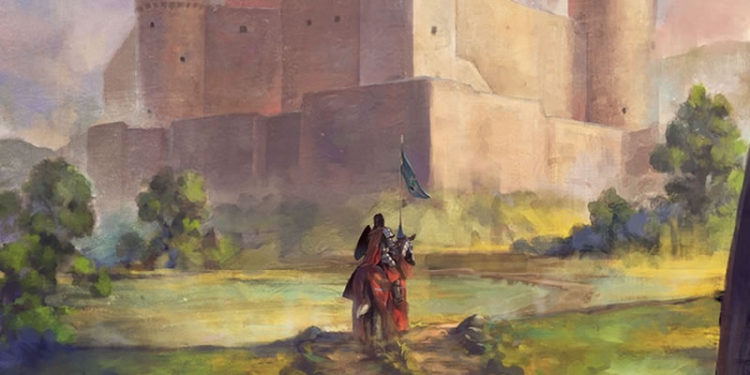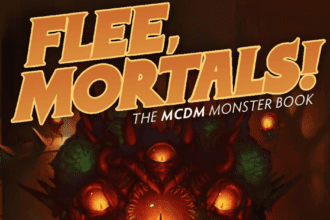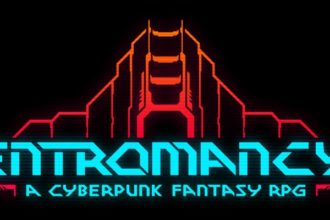
I’d love to get through this book more than one chapter at a time, or more than one article every six months, but uh. In case you’re reading this from the distant past (…cool!) or the future (I hope we all make it through this), early June 2020 is… it’s a whole thing, man.
Part One | Part Two | Part Three
Followers: Retainers
This chapter is 28 pages on followers, both units (hehehe, unit) and retainers. The text makes the unusual choice of ditching normal stat structures for retainers – instead of hit points, they have health levels and roll Con saves to avoid losing a health level. This is an incredibly baffling choice, as it replaces the damage roll and hit point math with a saving throw, against a DC that might or might not be listed in the attacker’s stat block, and tally-keeping. The text asserts the simplicity of this approach, but immediately undercuts that by getting things a bit wrong. “[T]hey lose one health level per die of damage” expresses a different idea than “Pretty simple. One roll, check off a health level box if you fail. Move on.”
The rules for healing a retainer make this much worse, as suddenly lay on hands is minor healing that can’t help a retainer. So what’s happened here is that the text introduces a system completely unfamiliar to 5e, expresses it inconsistently, and requires you to keep a completely different healing system in your head. Oh, and temporary hit points are a DM judgment call. I’ll take hit point math, thanks.
Beyond this, retainers have a functional +3 in all ability scores and +4 in a primary ability score (…sure?) and an additional +2 in two skills, +3 in all saves and +6 in their listed “good” saves, standard features for their ancestry, a signature attack, a few features they gain as they pick up levels, and a fixed (or not, your call) +6 to hit. Retainers level every other time the attached PC does, and cap out at 7th level.
We then get a retainer option that nominally reflects and boils down each subclass in the Player’s Handbook – for example, the barbarian listing offers the Reaver and the Spirit Warden. (Not gonna lie, even with all the exiting barbarian subclasses, Spirit Warden as a more mystical one is a great idea.) The boiled-down spell lists for casters might be the one place where I agree with the text’s goals.
Artisans
Next up, we have rules for artisans that join your stronghold and rules around developing their shops. A cool shop that the party patronizes and watches grow is a great part of the stronghold fantasy – it makes me think of Caed Nua in Pillars of Eternity and Tarrey Town in Breath of the Wild. Anyway, the point of many kinds of artisans is to gather creature parts while you’re out adventuring and bring them back to turn into something cool. You know, as an alternative to supporting PCs as crafters? (This is one of my personal missions in life, doesn’t have to be yours.) Some of the “artisans” do other things, but I’ll get to that in a minute.
There are harvesting rules – two checks, one Arcana and one Medicine (and thank goodness for Medicine having a use). You choose one of four different components to harvest, depending on which kind of crafter you’re supplying and what check DC you feel like taking on with your Medicine check. (An aside: I read a lot of rulebooks, and I’m honestly surprised at how hard it is to extract the thread of an idea from this section of the text.)
There are eleven types of artisans: alchemists, blacksmiths, captains, carpenters, farmers, masons, miners, sages, scribes, spies, and tailors. It’s almost three whole John le Carré novels! They each do one special thing for you, which scales by the level of their “laboratory.” Alchemists give you cost breaks on making potions; the monster parts you bring them determine which kinds of potions you can get. The alchemist entry also details two new potions: invisibility to monsters (that is, a specific type of monster) and monster control (again, specific to a kind of creature).
Blacksmiths get arrows and weapons of slaying specific monsters – like, if you kill and harvest one black dragon, you can more effectively kill another, maybe of an older age category. In a lot of cases this is still too narrow, because… there are a lot of types of dragons, and how many campaigns even get to two separate dragon types? (Assume I’m mapping that idea across the whole Monster Manual as well.) Depending on components and whatever recipes the DM decides they should have, blacksmiths might be able to make all kinds of magical gear.
Captains “craft” better soldiers, increasing their effective experience level by one grade. The level of the barracks (the captain’s “shop”) determines the number of units you can upgrade for any given battle. Weird to see the rules reward fighting on multiple fronts at a time. Units don’t get explained for a little while yet, though.
Carpenters reduce the cost of siege engines and the construction time of stronghold upgrades, both of which scale with the shop level. If they have any explicit use for monster parts, I’m not currently seeing it.
Farmers give you income: 100 gp each season. Their “shop” is the market, but it’s not explicit how leveling up the market affects anything. (It seems like it should be an income multiplier, but the text doesn’t say that.) If that’s the case, recouping the cost of each upgrade takes 5 seasons.
Masons repair damage to the stronghold, rated in a gold piece value of repairs they perform for free each week (250 * the quarry level), and cut down the stronghold upgrade time, stacking with the carpenter’s feature.
Miners (well, really, mine foremen) provide 500 gp per season, which doesn’t seem to improve with mine level. They also upgrade your units’ gear by one level, for a number of units equal to the mine’s level.
Sages give you information, and you apply that information to do more damage to enemies. It’s unfair of me maybe, but this bugs the crap out of me. We’ve talked for years about how everything boils down to combat in D&D, and it doesn’t have to be that way. Sages should help you find the answers to big questions, and since other parts of this book lay out big cosmic factions, there should be important things to learn. Knowledge should do more than grant advantage on an attack, negate one instance of resistance, or impose disadvantage on one saving throw. Those are collectively spent against a pool of uses equal to your sage’s shop level. The sage knowing the location of the nearest codex (a type of magic item described later in the book) is a much more interesting benefit.
I know how hard it is to write clear, mechanical features that relate to the exploration and social-interaction pillars. That said… no one should be doing more to help you explore and understand the world than a sage, and I hate to see that whole concept simply capitulate to more-better stabbing ability.
Scribes make scrolls, of course – or, they cut time and money costs for making scrolls, I should say. They also make scrolls of protection against (specific) monsters.
Spies provide counterintelligence, increasing espionage DCs for your enemies. I’m not sure how many DMs rely on ability checks for NPC espionage, or how they otherwise set those DCs (how helpful is a bonus of +4 to +8?). Your spy also handles your stronghold’s LinkedIn account handles recruiting for you, providing additional options when you roll for new followers. That’s assuming your followers are randomly generated, which the text is lukewarm about as an approach.
Tailors let you treat your d20 roll for any Charisma check as a 12, before modifiers, a number of times equal to your shop level. Hey, it’s an actual social pillar feature! That’s awesome. I do want to have a quick historical word with “barbarians don’t care about tailoring,” just because the Danes knew how to dress and bathe – and that was one of the things the Saxons hated about them.
Overall, I like the concepts of the various artisans, but I’d like to see the less-interesting ones either improved or cut, so that players don’t wind up disappointed.
Ambassadors
This is a fairly brief section, but basically you’ve got a new NPC you can always go interact with (I dunno, that would be huge in either of my campaigns right now). On a mechanical level, they let you buy or receive units from their ancestry. “Ambassador” as “mercenary clearing-house” is a very 2019-flavored cynicism. The stated goal of ambassadors is to sign an accord, and I just didn’t know Honda was that big of a brand in D&D.
Also, the text makes it very clear that they’re “rewards,” not enemy agents acting under official cover (until you ruin that relationship, in the way especially brash PCs do).
Allies
The final portion of this chapter is allies, the very powerful creatures who are well-disposed toward you, but don’t take orders. This is a fun kind of ally to have, because you have to go negotiate for help.
The Siege of Castle Rend
I never dig into adventures in detail in breakdowns, but this one delivers on the promise of getting PCs involved in politics and numerous unit-scale battles. It ends in awarding the PCs a stronghold. For what this book needs, that checks the boxes very neatly.
It also has creature stat blocks for a whole lot of orcs and several named NPCs, as well as unit stats (still not explained, that comes in a later chapter for some reason) for the orc, human, gnoll, dragonborn, and siege units. There are also new magic items: two weapons, one suit of armor, and one potion. I have quibbles on the magic items – a weapon that deals +2d6 necrotic, even if it only works for one character class, is probably too much for Rare – but magic item rarity is hard.
New Monsters
Oh man, the new monsters in this book are worth the price of admission. I’m not checking the math or anything – it just brings an angelic aesthetic right out of the Book of Isaiah. Anyone who played or ran the Dust to Dust campaign with me knows that is 100% Our Deal. The CRs stay surprisingly low, but that’s because players are meant to summon them as allies or engage with them in greater metaphysical struggles.
There’s also the Court of All Flesh, a cosmic faction of aberrations that compete over the Thrones of Chaos. A Roger Zelazny vibe, maybe – with bafflingly low CRs for the named NPCs and their apparent importance, but whatever, if I need them to be higher CR, I can crank that up basically on the fly.
I have my own ideas on what a fey court should look like – shocking, I know! – and some of these are harder to square with my own take. The Orchid Count, Oleander Dragon, Ash Marshall, and Sidereal Vizier are all incredible, their art most of all.
The Court of Elements is the most straightforward of them, but the stat blocks here are useful CR additions to the very limited range of elementals in the Monster Manual. Also I love the Storm Magistrate and the High Templar of Dust.
Gemstone dragons! With a page and a half of psionic manifestations and some unusual recharge, upcast, and death-spiraling mechanics. The psionic manifestations are… hm. I kinda want to break them down, but they’re only PC-accessible through a subrace. Notably, none of them have levels, just costs in psionic charges. Man, this system would not be okay for long in PC hands. (Notably, the gemstone dragon subrace doesn’t have a recharge die.)
The gemstone dragonborn is cool, though.
- +2 Int, +1 Wis.
- 30-ft speed.
- Crystal Armor grants +1 AC. Hey, I wrote a feature exactly like this in one of my homebrew races, neat!
- Limited Psionics gives you 4 psionic charges, which is reasonably similar to getting two 1st-level slots. You also learn two psionic manifestations: flay for damage (the scaling lacks a certain something, but so do standard dragonborn breath weapons) and distance for keeping enemies off you. It’s one of the biggest non-teleporting forced movement effects in the game at this point.
- In addition to speaking, reading, and writing Common and Draconic, you can overhear the telepathic speech of gemstone dragons if you’re within a mile. That last part probably comes up vanishingly close to never, but it is incredibly cool that one time. (Or hang a whole campaign on it – so cool.)
Finally, the Inexorables, the serial-numbers-filed-off version of Inevitables but upholding still more cosmic concepts. I would really never use these at their listed, single-digit CRs, unless the players had bought into the campaign with a level cap at between 5 and 8 for some reason. Great aesthetic, cool powers.
I’m going to end this article here – the final sections are Warfare and Magic Items, and I’m already past 2,000 words. Getting through a book like this in only four articles is pretty good… for me, at least. The chapters I’ve covered today have highlighted one of the flat-out coolest portions, as well as a section that leaves me wanting just one more development pass to nail a few more things down and get the balance smoothed out a little more.



